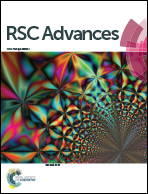Large magnetocaloric entropy change at room temperature in soft ferromagnetic manganites
Abstract
In this paper, La0.75Ca0.25−xNaxMnO3 (x = 0.15 and 0.20) samples were prepared by the flux method. Crystallographic study revealed that the x = 0.15 sample is characterized by the coexistence of a mixture of orthorhombic and rhombohedral structures with Pbnm and R![[3 with combining macron]](https://www.rsc.org/images/entities/char_0033_0304.gif) c space groups, respectively. While, the x = 0.20 sample crystallized in the rhombohedral structure with a R
c space groups, respectively. While, the x = 0.20 sample crystallized in the rhombohedral structure with a R![[3 with combining macron]](https://www.rsc.org/images/entities/char_0033_0304.gif) c space group. Magnetic data, under a magnetic field of 0.05 T, indicated that our samples undergo a ferromagnetic (FM)–paramagnetic (PM) phase transition, on increasing the temperature. The magnetic field dependence of the magnetocaloric properties of La0.75Ca0.25−xNaxMnO3 (x = 0.15 and 0.20) samples, with the second phase transition, was investigated. Near room temperature, the x = 0.20 sample exhibited a large magnetic entropy change with maxima of 6.01 and 3.12 J kg−1 K−1, respectively, under applied magnetic fields of 5 and 2 T. Also, the relative cooling power (RCP) was calculated. According to hysteresis cycles, for our studied samples, at 10 K a typical soft FM behavior with a low coercive field was observed. These results make our samples promising candidates for magnetic refrigerators, magnetic recording, and memory devices.
c space group. Magnetic data, under a magnetic field of 0.05 T, indicated that our samples undergo a ferromagnetic (FM)–paramagnetic (PM) phase transition, on increasing the temperature. The magnetic field dependence of the magnetocaloric properties of La0.75Ca0.25−xNaxMnO3 (x = 0.15 and 0.20) samples, with the second phase transition, was investigated. Near room temperature, the x = 0.20 sample exhibited a large magnetic entropy change with maxima of 6.01 and 3.12 J kg−1 K−1, respectively, under applied magnetic fields of 5 and 2 T. Also, the relative cooling power (RCP) was calculated. According to hysteresis cycles, for our studied samples, at 10 K a typical soft FM behavior with a low coercive field was observed. These results make our samples promising candidates for magnetic refrigerators, magnetic recording, and memory devices.



 Please wait while we load your content...
Please wait while we load your content...